Business Models Report: Macroeconomic Impact and Adaptations
VerifiedAdded on 2020/03/01
|10
|2379
|51
Report
AI Summary
This report delves into the multifaceted world of business models, examining their core components and strategic significance. It begins by defining business models as the operational frameworks of companies, highlighting their integration of vision, mission, goals, and organizational culture. The report explores business model archetypes, viewing them as personalities reflecting core values and strategic orientations, and also analyzes business models as activity systems involving resource acquisition, supply chain management, and stakeholder engagement. Furthermore, the report addresses the cost-revenue architecture of business models, emphasizing strategies to maximize revenues and reduce costs through technology, innovation, and stakeholder inclusion. It also examines how business models adapt to dynamic macroeconomic environments, including political, economic, and technological factors, which necessitate continuous restructuring to ensure sustainability and growth. The report concludes by underscoring the crucial role of business models in guiding operations, adding value, and adapting to market changes, emphasizing the need for strong employee and stakeholder support for effective implementation.
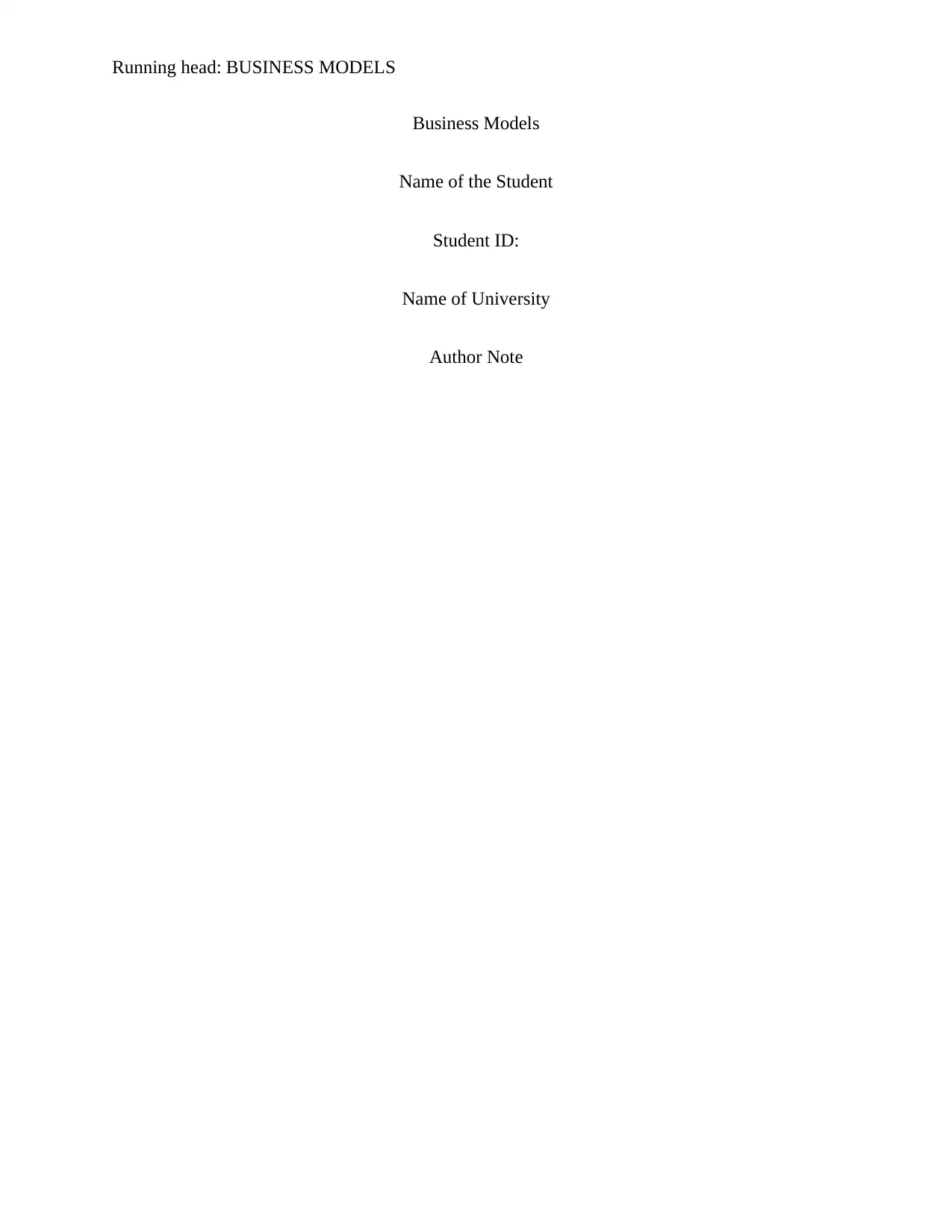
Running head: BUSINESS MODELS
Business Models
Name of the Student
Student ID:
Name of University
Author Note
Business Models
Name of the Student
Student ID:
Name of University
Author Note
Paraphrase This Document
Need a fresh take? Get an instant paraphrase of this document with our AI Paraphraser
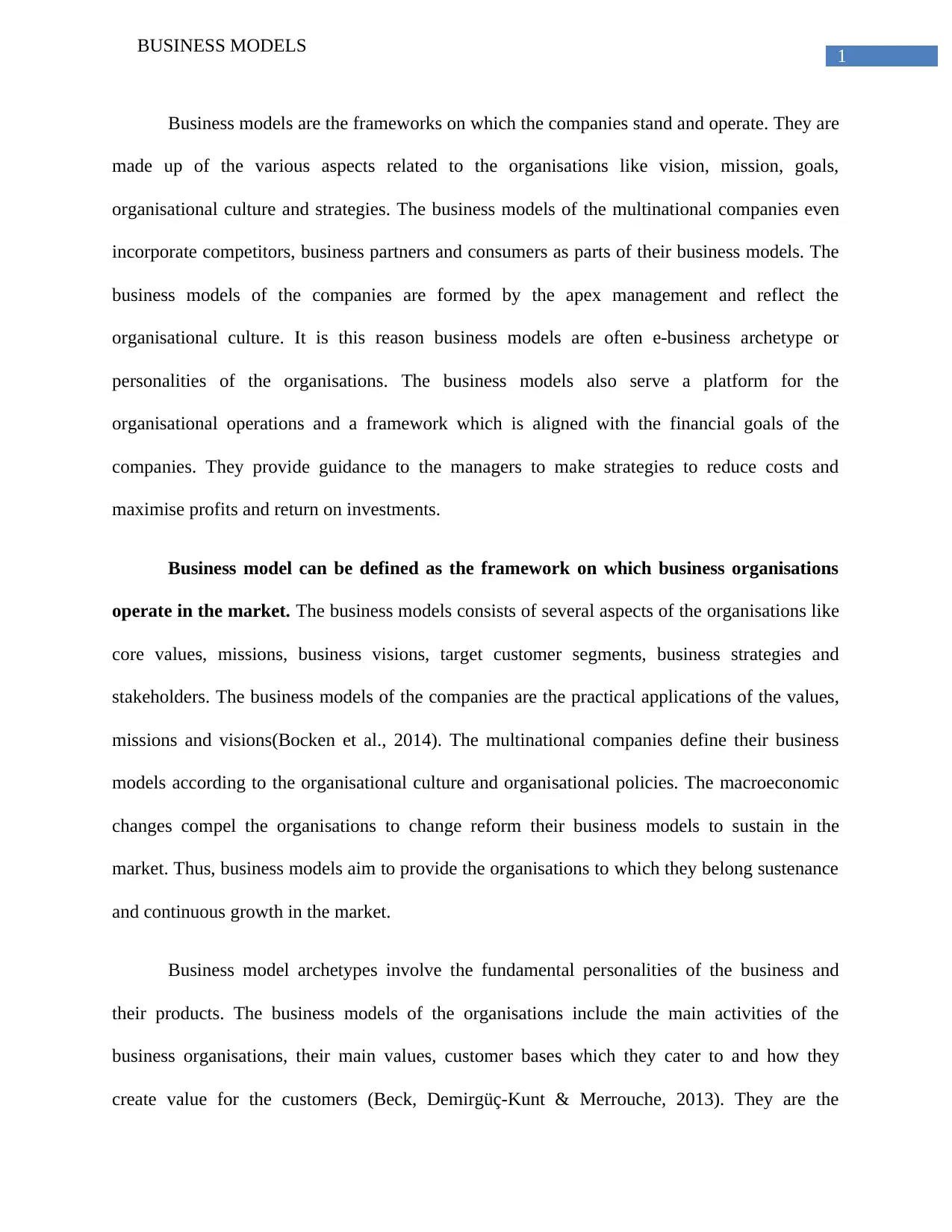
1
BUSINESS MODELS
Business models are the frameworks on which the companies stand and operate. They are
made up of the various aspects related to the organisations like vision, mission, goals,
organisational culture and strategies. The business models of the multinational companies even
incorporate competitors, business partners and consumers as parts of their business models. The
business models of the companies are formed by the apex management and reflect the
organisational culture. It is this reason business models are often e-business archetype or
personalities of the organisations. The business models also serve a platform for the
organisational operations and a framework which is aligned with the financial goals of the
companies. They provide guidance to the managers to make strategies to reduce costs and
maximise profits and return on investments.
Business model can be defined as the framework on which business organisations
operate in the market. The business models consists of several aspects of the organisations like
core values, missions, business visions, target customer segments, business strategies and
stakeholders. The business models of the companies are the practical applications of the values,
missions and visions(Bocken et al., 2014). The multinational companies define their business
models according to the organisational culture and organisational policies. The macroeconomic
changes compel the organisations to change reform their business models to sustain in the
market. Thus, business models aim to provide the organisations to which they belong sustenance
and continuous growth in the market.
Business model archetypes involve the fundamental personalities of the business and
their products. The business models of the organisations include the main activities of the
business organisations, their main values, customer bases which they cater to and how they
create value for the customers (Beck, Demirgüç-Kunt & Merrouche, 2013). They are the
BUSINESS MODELS
Business models are the frameworks on which the companies stand and operate. They are
made up of the various aspects related to the organisations like vision, mission, goals,
organisational culture and strategies. The business models of the multinational companies even
incorporate competitors, business partners and consumers as parts of their business models. The
business models of the companies are formed by the apex management and reflect the
organisational culture. It is this reason business models are often e-business archetype or
personalities of the organisations. The business models also serve a platform for the
organisational operations and a framework which is aligned with the financial goals of the
companies. They provide guidance to the managers to make strategies to reduce costs and
maximise profits and return on investments.
Business model can be defined as the framework on which business organisations
operate in the market. The business models consists of several aspects of the organisations like
core values, missions, business visions, target customer segments, business strategies and
stakeholders. The business models of the companies are the practical applications of the values,
missions and visions(Bocken et al., 2014). The multinational companies define their business
models according to the organisational culture and organisational policies. The macroeconomic
changes compel the organisations to change reform their business models to sustain in the
market. Thus, business models aim to provide the organisations to which they belong sustenance
and continuous growth in the market.
Business model archetypes involve the fundamental personalities of the business and
their products. The business models of the organisations include the main activities of the
business organisations, their main values, customer bases which they cater to and how they
create value for the customers (Beck, Demirgüç-Kunt & Merrouche, 2013). They are the
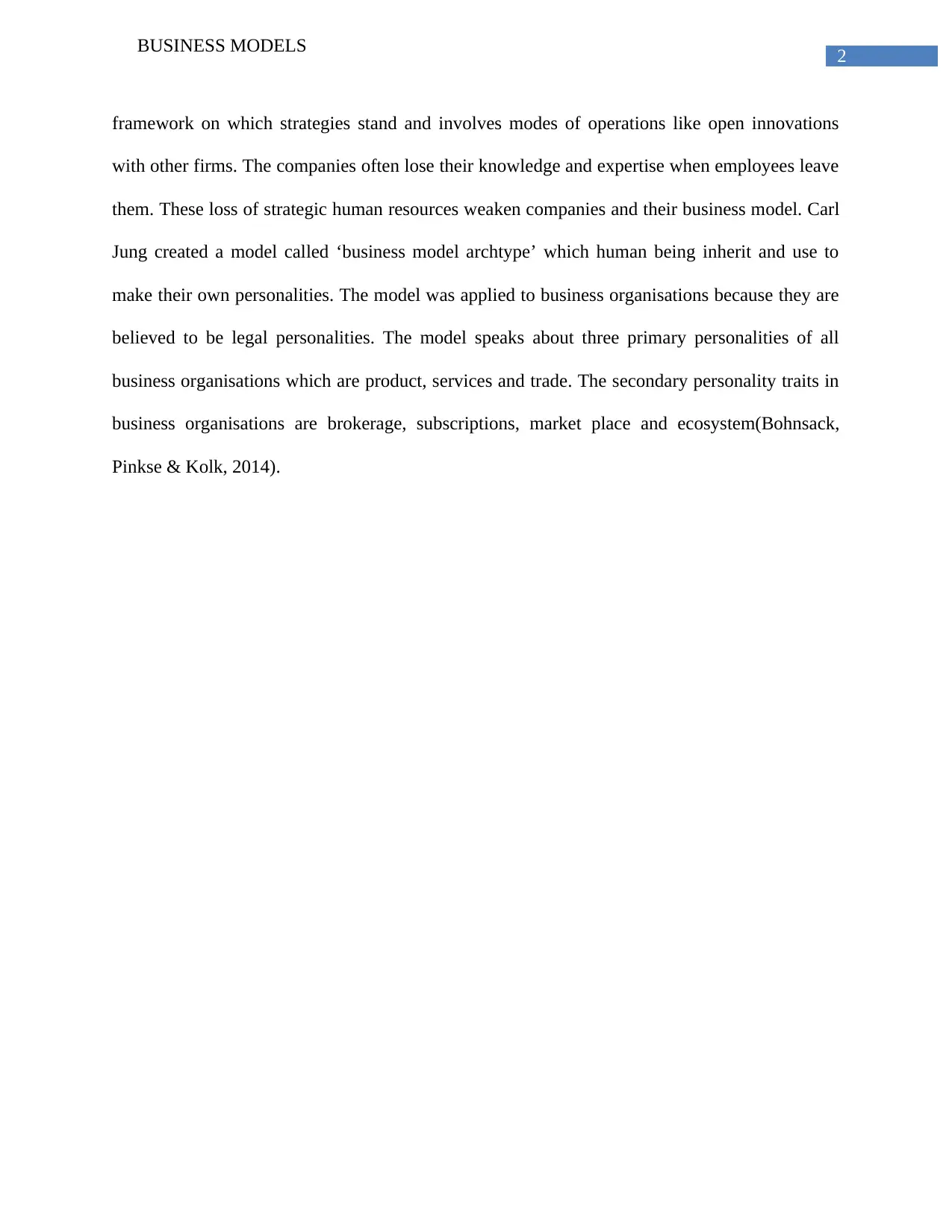
2
BUSINESS MODELS
framework on which strategies stand and involves modes of operations like open innovations
with other firms. The companies often lose their knowledge and expertise when employees leave
them. These loss of strategic human resources weaken companies and their business model. Carl
Jung created a model called ‘business model archtype’ which human being inherit and use to
make their own personalities. The model was applied to business organisations because they are
believed to be legal personalities. The model speaks about three primary personalities of all
business organisations which are product, services and trade. The secondary personality traits in
business organisations are brokerage, subscriptions, market place and ecosystem(Bohnsack,
Pinkse & Kolk, 2014).
BUSINESS MODELS
framework on which strategies stand and involves modes of operations like open innovations
with other firms. The companies often lose their knowledge and expertise when employees leave
them. These loss of strategic human resources weaken companies and their business model. Carl
Jung created a model called ‘business model archtype’ which human being inherit and use to
make their own personalities. The model was applied to business organisations because they are
believed to be legal personalities. The model speaks about three primary personalities of all
business organisations which are product, services and trade. The secondary personality traits in
business organisations are brokerage, subscriptions, market place and ecosystem(Bohnsack,
Pinkse & Kolk, 2014).
⊘ This is a preview!⊘
Do you want full access?
Subscribe today to unlock all pages.

Trusted by 1+ million students worldwide
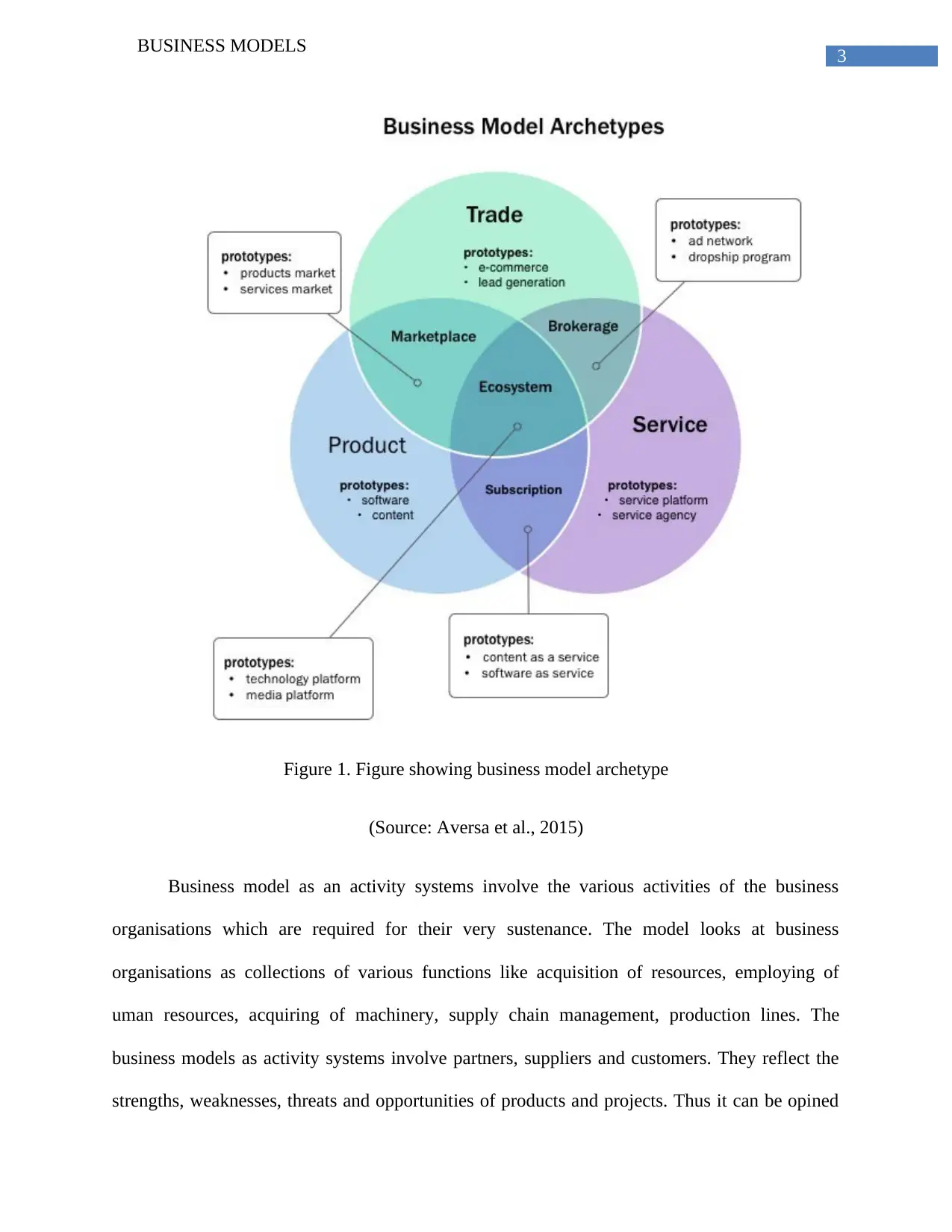
3
BUSINESS MODELS
Figure 1. Figure showing business model archetype
(Source: Aversa et al., 2015)
Business model as an activity systems involve the various activities of the business
organisations which are required for their very sustenance. The model looks at business
organisations as collections of various functions like acquisition of resources, employing of
uman resources, acquiring of machinery, supply chain management, production lines. The
business models as activity systems involve partners, suppliers and customers. They reflect the
strengths, weaknesses, threats and opportunities of products and projects. Thus it can be opined
BUSINESS MODELS
Figure 1. Figure showing business model archetype
(Source: Aversa et al., 2015)
Business model as an activity systems involve the various activities of the business
organisations which are required for their very sustenance. The model looks at business
organisations as collections of various functions like acquisition of resources, employing of
uman resources, acquiring of machinery, supply chain management, production lines. The
business models as activity systems involve partners, suppliers and customers. They reflect the
strengths, weaknesses, threats and opportunities of products and projects. Thus it can be opined
Paraphrase This Document
Need a fresh take? Get an instant paraphrase of this document with our AI Paraphraser
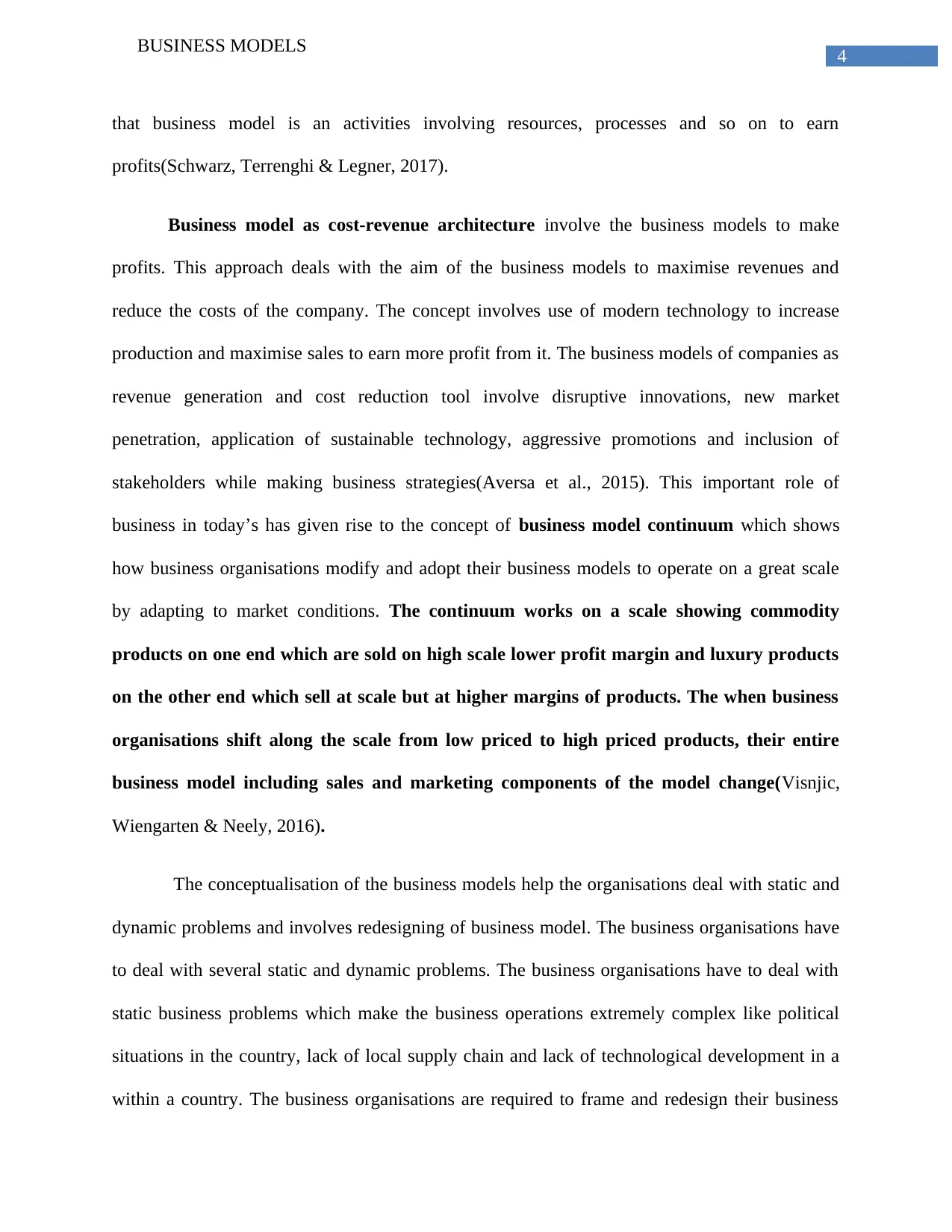
4
BUSINESS MODELS
that business model is an activities involving resources, processes and so on to earn
profits(Schwarz, Terrenghi & Legner, 2017).
Business model as cost-revenue architecture involve the business models to make
profits. This approach deals with the aim of the business models to maximise revenues and
reduce the costs of the company. The concept involves use of modern technology to increase
production and maximise sales to earn more profit from it. The business models of companies as
revenue generation and cost reduction tool involve disruptive innovations, new market
penetration, application of sustainable technology, aggressive promotions and inclusion of
stakeholders while making business strategies(Aversa et al., 2015). This important role of
business in today’s has given rise to the concept of business model continuum which shows
how business organisations modify and adopt their business models to operate on a great scale
by adapting to market conditions. The continuum works on a scale showing commodity
products on one end which are sold on high scale lower profit margin and luxury products
on the other end which sell at scale but at higher margins of products. The when business
organisations shift along the scale from low priced to high priced products, their entire
business model including sales and marketing components of the model change(Visnjic,
Wiengarten & Neely, 2016).
The conceptualisation of the business models help the organisations deal with static and
dynamic problems and involves redesigning of business model. The business organisations have
to deal with several static and dynamic problems. The business organisations have to deal with
static business problems which make the business operations extremely complex like political
situations in the country, lack of local supply chain and lack of technological development in a
within a country. The business organisations are required to frame and redesign their business
BUSINESS MODELS
that business model is an activities involving resources, processes and so on to earn
profits(Schwarz, Terrenghi & Legner, 2017).
Business model as cost-revenue architecture involve the business models to make
profits. This approach deals with the aim of the business models to maximise revenues and
reduce the costs of the company. The concept involves use of modern technology to increase
production and maximise sales to earn more profit from it. The business models of companies as
revenue generation and cost reduction tool involve disruptive innovations, new market
penetration, application of sustainable technology, aggressive promotions and inclusion of
stakeholders while making business strategies(Aversa et al., 2015). This important role of
business in today’s has given rise to the concept of business model continuum which shows
how business organisations modify and adopt their business models to operate on a great scale
by adapting to market conditions. The continuum works on a scale showing commodity
products on one end which are sold on high scale lower profit margin and luxury products
on the other end which sell at scale but at higher margins of products. The when business
organisations shift along the scale from low priced to high priced products, their entire
business model including sales and marketing components of the model change(Visnjic,
Wiengarten & Neely, 2016).
The conceptualisation of the business models help the organisations deal with static and
dynamic problems and involves redesigning of business model. The business organisations have
to deal with several static and dynamic problems. The business organisations have to deal with
static business problems which make the business operations extremely complex like political
situations in the country, lack of local supply chain and lack of technological development in a
within a country. The business organisations are required to frame and redesign their business
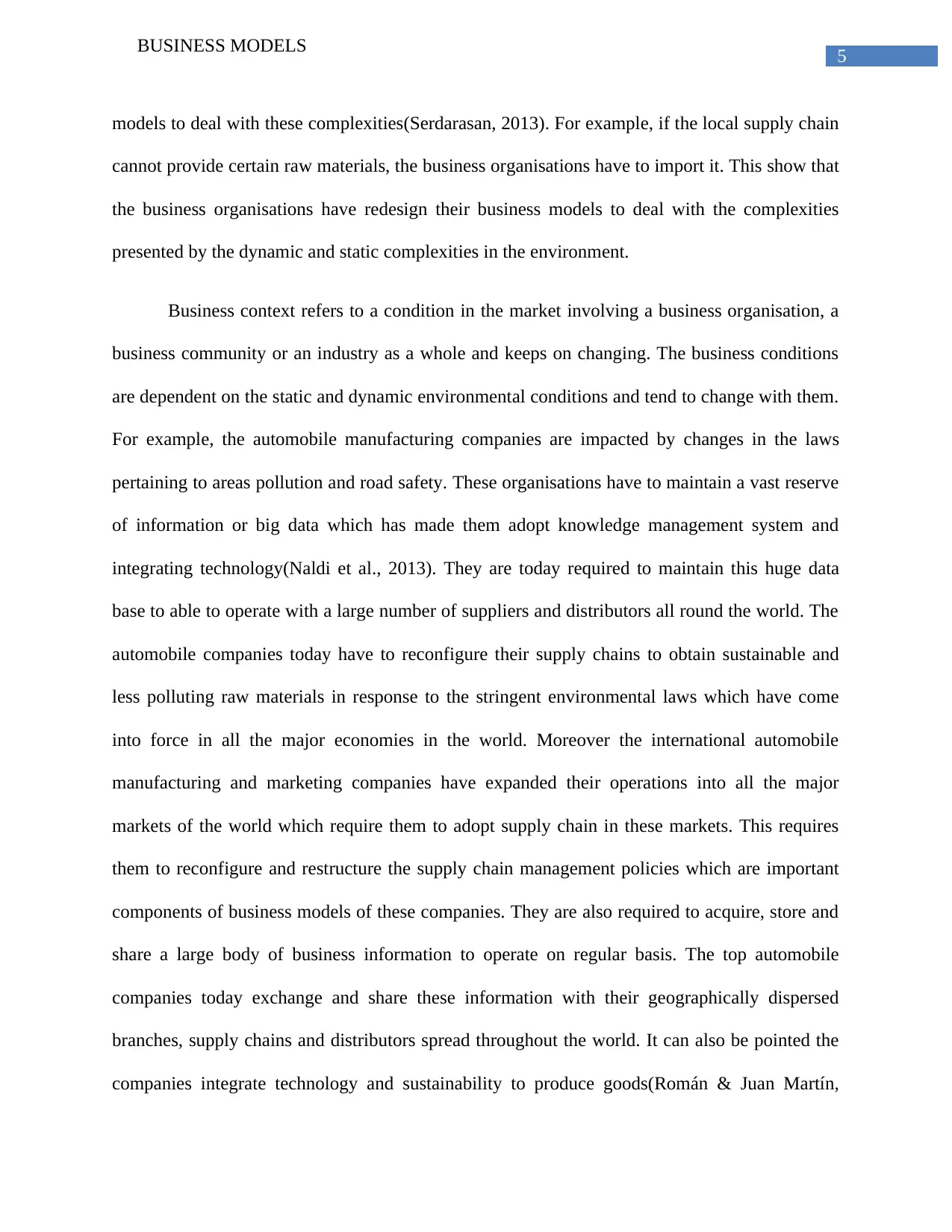
5
BUSINESS MODELS
models to deal with these complexities(Serdarasan, 2013). For example, if the local supply chain
cannot provide certain raw materials, the business organisations have to import it. This show that
the business organisations have redesign their business models to deal with the complexities
presented by the dynamic and static complexities in the environment.
Business context refers to a condition in the market involving a business organisation, a
business community or an industry as a whole and keeps on changing. The business conditions
are dependent on the static and dynamic environmental conditions and tend to change with them.
For example, the automobile manufacturing companies are impacted by changes in the laws
pertaining to areas pollution and road safety. These organisations have to maintain a vast reserve
of information or big data which has made them adopt knowledge management system and
integrating technology(Naldi et al., 2013). They are today required to maintain this huge data
base to able to operate with a large number of suppliers and distributors all round the world. The
automobile companies today have to reconfigure their supply chains to obtain sustainable and
less polluting raw materials in response to the stringent environmental laws which have come
into force in all the major economies in the world. Moreover the international automobile
manufacturing and marketing companies have expanded their operations into all the major
markets of the world which require them to adopt supply chain in these markets. This requires
them to reconfigure and restructure the supply chain management policies which are important
components of business models of these companies. They are also required to acquire, store and
share a large body of business information to operate on regular basis. The top automobile
companies today exchange and share these information with their geographically dispersed
branches, supply chains and distributors spread throughout the world. It can also be pointed the
companies integrate technology and sustainability to produce goods(Román & Juan Martín,
BUSINESS MODELS
models to deal with these complexities(Serdarasan, 2013). For example, if the local supply chain
cannot provide certain raw materials, the business organisations have to import it. This show that
the business organisations have redesign their business models to deal with the complexities
presented by the dynamic and static complexities in the environment.
Business context refers to a condition in the market involving a business organisation, a
business community or an industry as a whole and keeps on changing. The business conditions
are dependent on the static and dynamic environmental conditions and tend to change with them.
For example, the automobile manufacturing companies are impacted by changes in the laws
pertaining to areas pollution and road safety. These organisations have to maintain a vast reserve
of information or big data which has made them adopt knowledge management system and
integrating technology(Naldi et al., 2013). They are today required to maintain this huge data
base to able to operate with a large number of suppliers and distributors all round the world. The
automobile companies today have to reconfigure their supply chains to obtain sustainable and
less polluting raw materials in response to the stringent environmental laws which have come
into force in all the major economies in the world. Moreover the international automobile
manufacturing and marketing companies have expanded their operations into all the major
markets of the world which require them to adopt supply chain in these markets. This requires
them to reconfigure and restructure the supply chain management policies which are important
components of business models of these companies. They are also required to acquire, store and
share a large body of business information to operate on regular basis. The top automobile
companies today exchange and share these information with their geographically dispersed
branches, supply chains and distributors spread throughout the world. It can also be pointed the
companies integrate technology and sustainability to produce goods(Román & Juan Martín,
⊘ This is a preview!⊘
Do you want full access?
Subscribe today to unlock all pages.

Trusted by 1+ million students worldwide
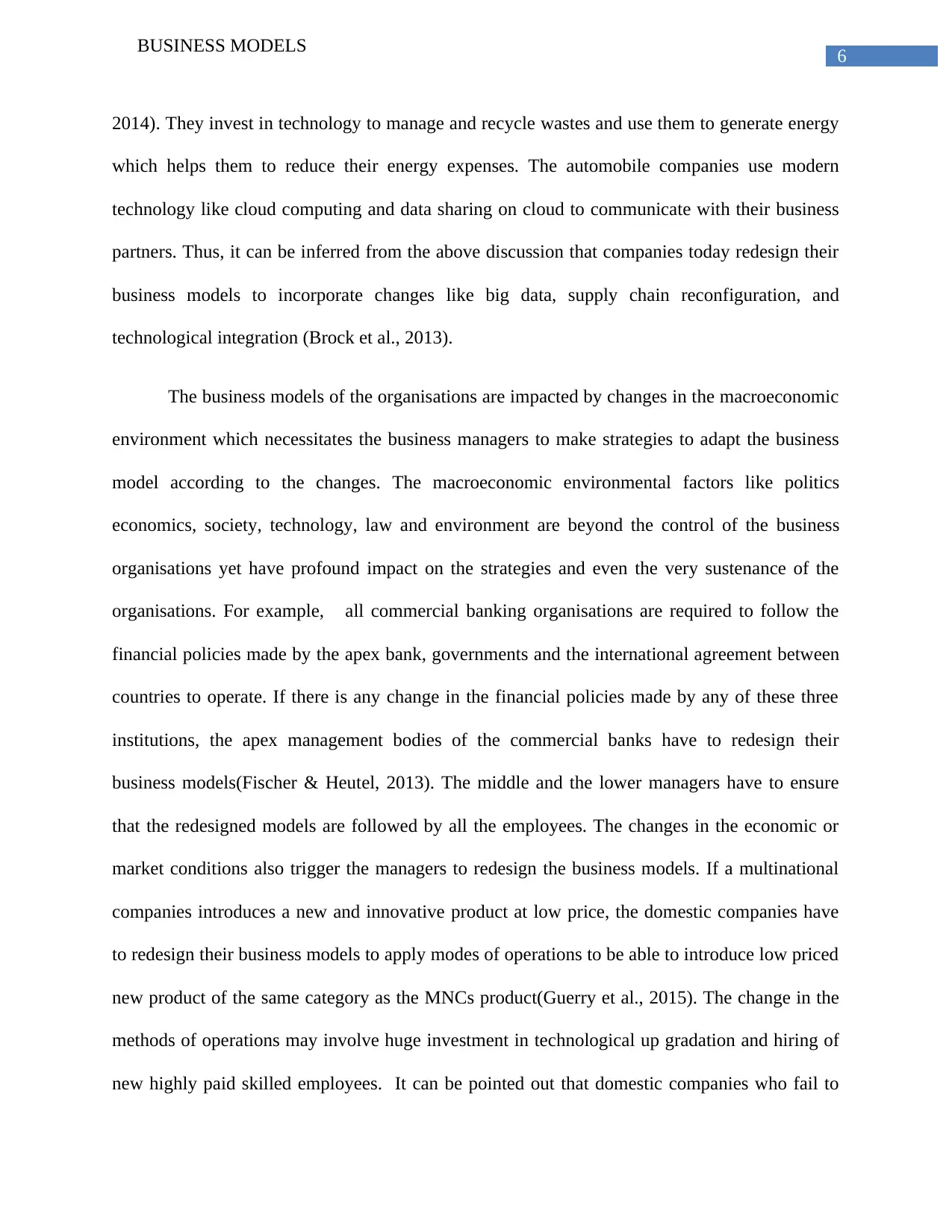
6
BUSINESS MODELS
2014). They invest in technology to manage and recycle wastes and use them to generate energy
which helps them to reduce their energy expenses. The automobile companies use modern
technology like cloud computing and data sharing on cloud to communicate with their business
partners. Thus, it can be inferred from the above discussion that companies today redesign their
business models to incorporate changes like big data, supply chain reconfiguration, and
technological integration (Brock et al., 2013).
The business models of the organisations are impacted by changes in the macroeconomic
environment which necessitates the business managers to make strategies to adapt the business
model according to the changes. The macroeconomic environmental factors like politics
economics, society, technology, law and environment are beyond the control of the business
organisations yet have profound impact on the strategies and even the very sustenance of the
organisations. For example, all commercial banking organisations are required to follow the
financial policies made by the apex bank, governments and the international agreement between
countries to operate. If there is any change in the financial policies made by any of these three
institutions, the apex management bodies of the commercial banks have to redesign their
business models(Fischer & Heutel, 2013). The middle and the lower managers have to ensure
that the redesigned models are followed by all the employees. The changes in the economic or
market conditions also trigger the managers to redesign the business models. If a multinational
companies introduces a new and innovative product at low price, the domestic companies have
to redesign their business models to apply modes of operations to be able to introduce low priced
new product of the same category as the MNCs product(Guerry et al., 2015). The change in the
methods of operations may involve huge investment in technological up gradation and hiring of
new highly paid skilled employees. It can be pointed out that domestic companies who fail to
BUSINESS MODELS
2014). They invest in technology to manage and recycle wastes and use them to generate energy
which helps them to reduce their energy expenses. The automobile companies use modern
technology like cloud computing and data sharing on cloud to communicate with their business
partners. Thus, it can be inferred from the above discussion that companies today redesign their
business models to incorporate changes like big data, supply chain reconfiguration, and
technological integration (Brock et al., 2013).
The business models of the organisations are impacted by changes in the macroeconomic
environment which necessitates the business managers to make strategies to adapt the business
model according to the changes. The macroeconomic environmental factors like politics
economics, society, technology, law and environment are beyond the control of the business
organisations yet have profound impact on the strategies and even the very sustenance of the
organisations. For example, all commercial banking organisations are required to follow the
financial policies made by the apex bank, governments and the international agreement between
countries to operate. If there is any change in the financial policies made by any of these three
institutions, the apex management bodies of the commercial banks have to redesign their
business models(Fischer & Heutel, 2013). The middle and the lower managers have to ensure
that the redesigned models are followed by all the employees. The changes in the economic or
market conditions also trigger the managers to redesign the business models. If a multinational
companies introduces a new and innovative product at low price, the domestic companies have
to redesign their business models to apply modes of operations to be able to introduce low priced
new product of the same category as the MNCs product(Guerry et al., 2015). The change in the
methods of operations may involve huge investment in technological up gradation and hiring of
new highly paid skilled employees. It can be pointed out that domestic companies who fail to
Paraphrase This Document
Need a fresh take? Get an instant paraphrase of this document with our AI Paraphraser
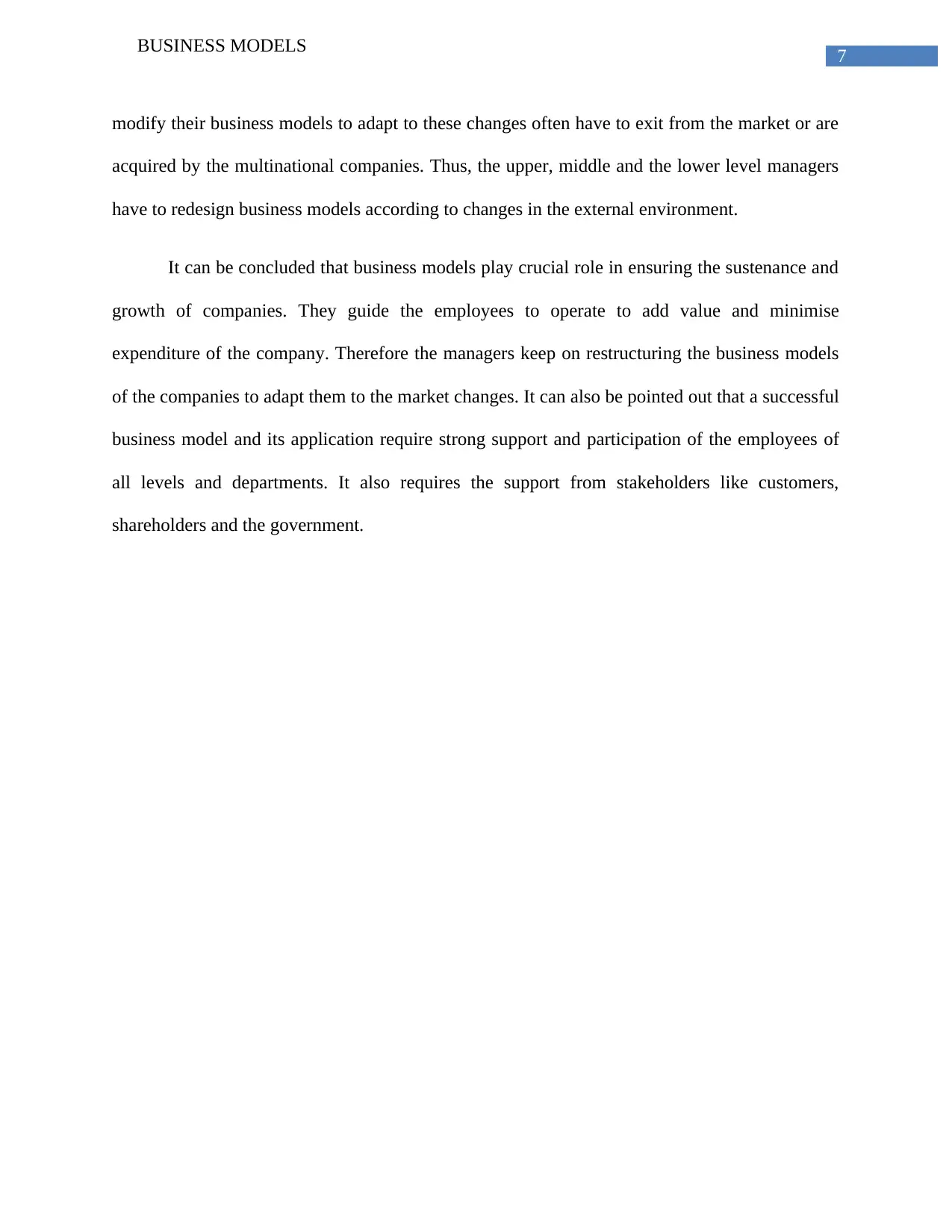
7
BUSINESS MODELS
modify their business models to adapt to these changes often have to exit from the market or are
acquired by the multinational companies. Thus, the upper, middle and the lower level managers
have to redesign business models according to changes in the external environment.
It can be concluded that business models play crucial role in ensuring the sustenance and
growth of companies. They guide the employees to operate to add value and minimise
expenditure of the company. Therefore the managers keep on restructuring the business models
of the companies to adapt them to the market changes. It can also be pointed out that a successful
business model and its application require strong support and participation of the employees of
all levels and departments. It also requires the support from stakeholders like customers,
shareholders and the government.
BUSINESS MODELS
modify their business models to adapt to these changes often have to exit from the market or are
acquired by the multinational companies. Thus, the upper, middle and the lower level managers
have to redesign business models according to changes in the external environment.
It can be concluded that business models play crucial role in ensuring the sustenance and
growth of companies. They guide the employees to operate to add value and minimise
expenditure of the company. Therefore the managers keep on restructuring the business models
of the companies to adapt them to the market changes. It can also be pointed out that a successful
business model and its application require strong support and participation of the employees of
all levels and departments. It also requires the support from stakeholders like customers,
shareholders and the government.
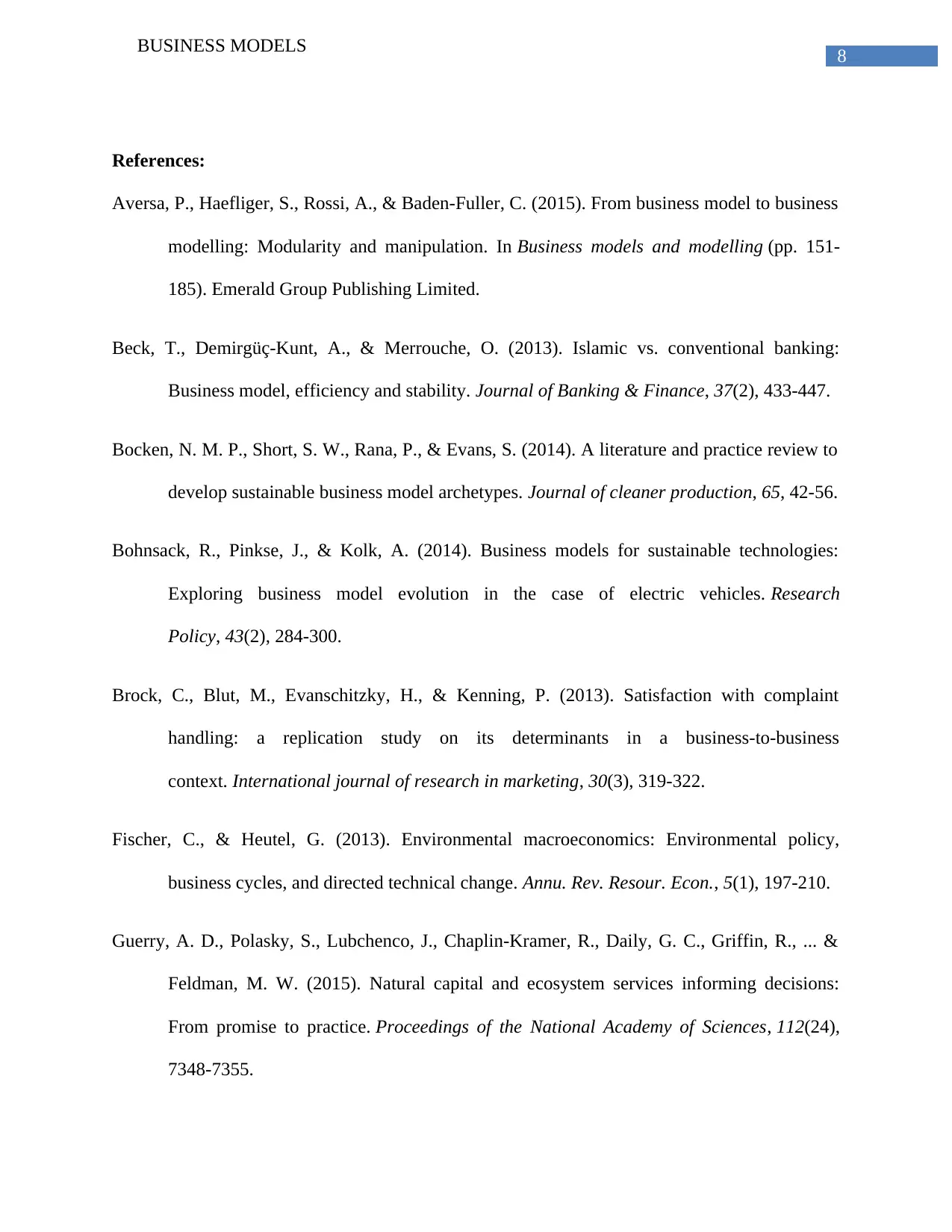
8
BUSINESS MODELS
References:
Aversa, P., Haefliger, S., Rossi, A., & Baden-Fuller, C. (2015). From business model to business
modelling: Modularity and manipulation. In Business models and modelling (pp. 151-
185). Emerald Group Publishing Limited.
Beck, T., Demirgüç-Kunt, A., & Merrouche, O. (2013). Islamic vs. conventional banking:
Business model, efficiency and stability. Journal of Banking & Finance, 37(2), 433-447.
Bocken, N. M. P., Short, S. W., Rana, P., & Evans, S. (2014). A literature and practice review to
develop sustainable business model archetypes. Journal of cleaner production, 65, 42-56.
Bohnsack, R., Pinkse, J., & Kolk, A. (2014). Business models for sustainable technologies:
Exploring business model evolution in the case of electric vehicles. Research
Policy, 43(2), 284-300.
Brock, C., Blut, M., Evanschitzky, H., & Kenning, P. (2013). Satisfaction with complaint
handling: a replication study on its determinants in a business-to-business
context. International journal of research in marketing, 30(3), 319-322.
Fischer, C., & Heutel, G. (2013). Environmental macroeconomics: Environmental policy,
business cycles, and directed technical change. Annu. Rev. Resour. Econ., 5(1), 197-210.
Guerry, A. D., Polasky, S., Lubchenco, J., Chaplin-Kramer, R., Daily, G. C., Griffin, R., ... &
Feldman, M. W. (2015). Natural capital and ecosystem services informing decisions:
From promise to practice. Proceedings of the National Academy of Sciences, 112(24),
7348-7355.
BUSINESS MODELS
References:
Aversa, P., Haefliger, S., Rossi, A., & Baden-Fuller, C. (2015). From business model to business
modelling: Modularity and manipulation. In Business models and modelling (pp. 151-
185). Emerald Group Publishing Limited.
Beck, T., Demirgüç-Kunt, A., & Merrouche, O. (2013). Islamic vs. conventional banking:
Business model, efficiency and stability. Journal of Banking & Finance, 37(2), 433-447.
Bocken, N. M. P., Short, S. W., Rana, P., & Evans, S. (2014). A literature and practice review to
develop sustainable business model archetypes. Journal of cleaner production, 65, 42-56.
Bohnsack, R., Pinkse, J., & Kolk, A. (2014). Business models for sustainable technologies:
Exploring business model evolution in the case of electric vehicles. Research
Policy, 43(2), 284-300.
Brock, C., Blut, M., Evanschitzky, H., & Kenning, P. (2013). Satisfaction with complaint
handling: a replication study on its determinants in a business-to-business
context. International journal of research in marketing, 30(3), 319-322.
Fischer, C., & Heutel, G. (2013). Environmental macroeconomics: Environmental policy,
business cycles, and directed technical change. Annu. Rev. Resour. Econ., 5(1), 197-210.
Guerry, A. D., Polasky, S., Lubchenco, J., Chaplin-Kramer, R., Daily, G. C., Griffin, R., ... &
Feldman, M. W. (2015). Natural capital and ecosystem services informing decisions:
From promise to practice. Proceedings of the National Academy of Sciences, 112(24),
7348-7355.
⊘ This is a preview!⊘
Do you want full access?
Subscribe today to unlock all pages.

Trusted by 1+ million students worldwide
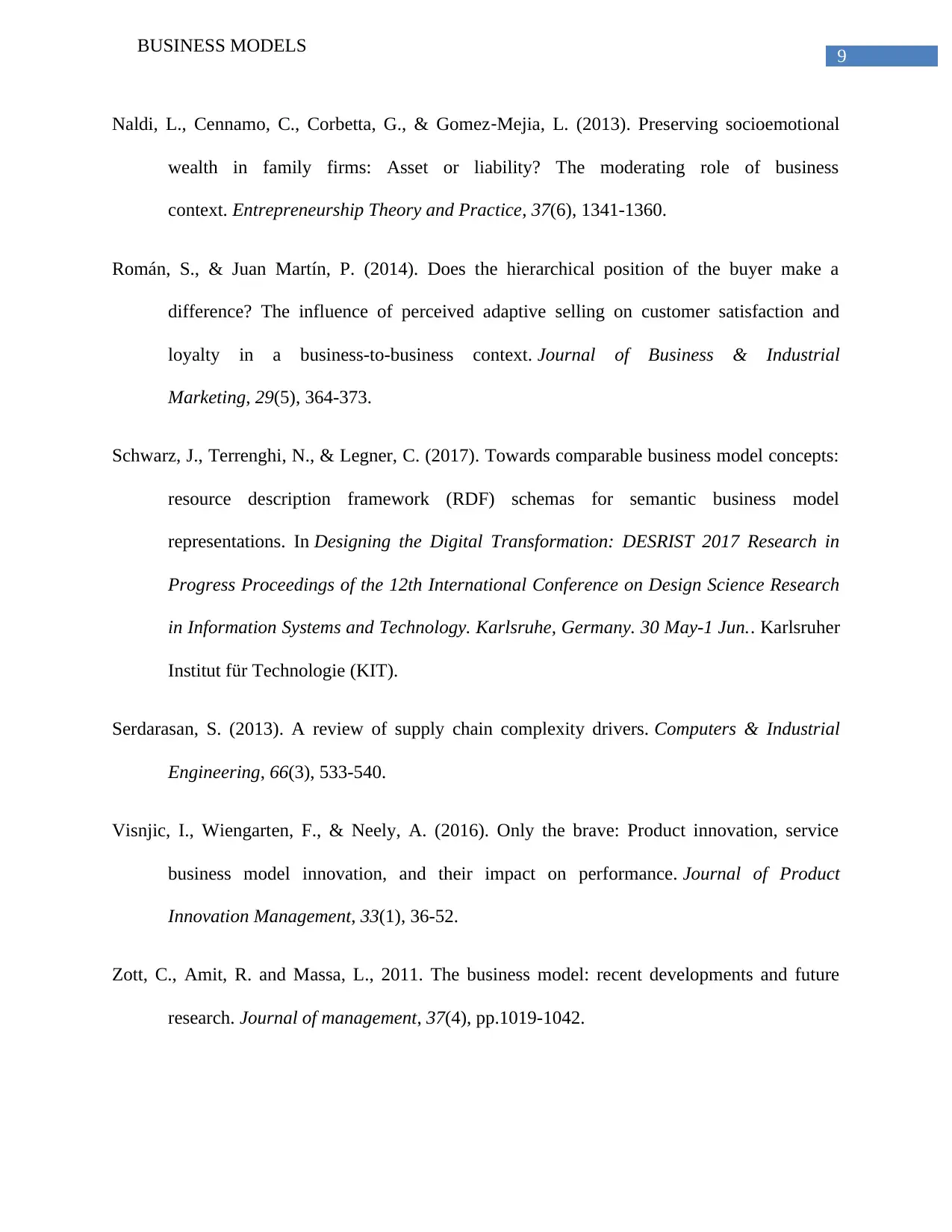
9
BUSINESS MODELS
Naldi, L., Cennamo, C., Corbetta, G., & Gomez‐Mejia, L. (2013). Preserving socioemotional
wealth in family firms: Asset or liability? The moderating role of business
context. Entrepreneurship Theory and Practice, 37(6), 1341-1360.
Román, S., & Juan Martín, P. (2014). Does the hierarchical position of the buyer make a
difference? The influence of perceived adaptive selling on customer satisfaction and
loyalty in a business-to-business context. Journal of Business & Industrial
Marketing, 29(5), 364-373.
Schwarz, J., Terrenghi, N., & Legner, C. (2017). Towards comparable business model concepts:
resource description framework (RDF) schemas for semantic business model
representations. In Designing the Digital Transformation: DESRIST 2017 Research in
Progress Proceedings of the 12th International Conference on Design Science Research
in Information Systems and Technology. Karlsruhe, Germany. 30 May-1 Jun.. Karlsruher
Institut für Technologie (KIT).
Serdarasan, S. (2013). A review of supply chain complexity drivers. Computers & Industrial
Engineering, 66(3), 533-540.
Visnjic, I., Wiengarten, F., & Neely, A. (2016). Only the brave: Product innovation, service
business model innovation, and their impact on performance. Journal of Product
Innovation Management, 33(1), 36-52.
Zott, C., Amit, R. and Massa, L., 2011. The business model: recent developments and future
research. Journal of management, 37(4), pp.1019-1042.
BUSINESS MODELS
Naldi, L., Cennamo, C., Corbetta, G., & Gomez‐Mejia, L. (2013). Preserving socioemotional
wealth in family firms: Asset or liability? The moderating role of business
context. Entrepreneurship Theory and Practice, 37(6), 1341-1360.
Román, S., & Juan Martín, P. (2014). Does the hierarchical position of the buyer make a
difference? The influence of perceived adaptive selling on customer satisfaction and
loyalty in a business-to-business context. Journal of Business & Industrial
Marketing, 29(5), 364-373.
Schwarz, J., Terrenghi, N., & Legner, C. (2017). Towards comparable business model concepts:
resource description framework (RDF) schemas for semantic business model
representations. In Designing the Digital Transformation: DESRIST 2017 Research in
Progress Proceedings of the 12th International Conference on Design Science Research
in Information Systems and Technology. Karlsruhe, Germany. 30 May-1 Jun.. Karlsruher
Institut für Technologie (KIT).
Serdarasan, S. (2013). A review of supply chain complexity drivers. Computers & Industrial
Engineering, 66(3), 533-540.
Visnjic, I., Wiengarten, F., & Neely, A. (2016). Only the brave: Product innovation, service
business model innovation, and their impact on performance. Journal of Product
Innovation Management, 33(1), 36-52.
Zott, C., Amit, R. and Massa, L., 2011. The business model: recent developments and future
research. Journal of management, 37(4), pp.1019-1042.
1 out of 10
Related Documents
Your All-in-One AI-Powered Toolkit for Academic Success.
+13062052269
info@desklib.com
Available 24*7 on WhatsApp / Email
![[object Object]](/_next/static/media/star-bottom.7253800d.svg)
Unlock your academic potential
Copyright © 2020–2025 A2Z Services. All Rights Reserved. Developed and managed by ZUCOL.




